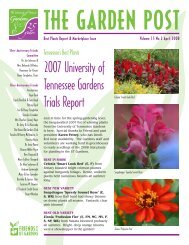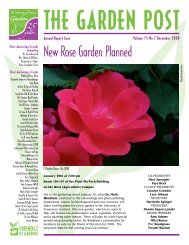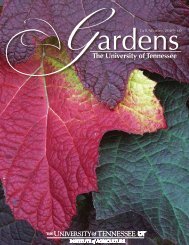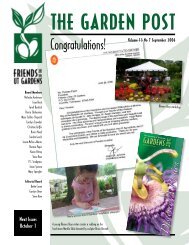Fall|Winter 2012-13 - UT Gardens - The University of Tennessee
Fall|Winter 2012-13 - UT Gardens - The University of Tennessee
Fall|Winter 2012-13 - UT Gardens - The University of Tennessee
Create successful ePaper yourself
Turn your PDF publications into a flip-book with our unique Google optimized e-Paper software.
It was a gorgeous fall day and I stood talking<br />
to Dale Skaggs, horticulture director <strong>of</strong><br />
Dixon <strong>Gardens</strong> and Gallery in Memphis. We<br />
were in the beautiful woodland garden at the<br />
Dixon. Sporadically someone would come down<br />
the sidewalk, heading for a program at the pavilion.<br />
It was amusing us to see some <strong>of</strong> them halt as they<br />
neared the building, throw their heads up and sniff<br />
the air.<br />
Sometimes we were mid-sentence and let them hunt<br />
for the source <strong>of</strong> the intoxicating fragrance for a<br />
bit. Sooner or later, we would call out “sweet olive,”<br />
and point to the large, dark green shrubs that grew<br />
against the building. Perhaps they would have found<br />
the flowers eventually by scent, but not easily by<br />
sight, since they are diminutive and a bland white —<br />
produced in small clusters tucked down into the<br />
leaf axils.<br />
Gardeners <strong>of</strong> another era, and especially further<br />
south perhaps, would not have been strangers to the<br />
shrub. While sweet olive, (or tea olive) is a member <strong>of</strong><br />
the olive family, it is more specifically an osmanthus,<br />
and is more <strong>of</strong>ten called by this name in today’s<br />
gardening circles. Even more specifically, sweet olive<br />
refers to Osmanthus fragrans, which is the least cold<br />
hardy <strong>of</strong> the commercially important osmanthus, and<br />
was mostly considered reliable only in zone 8 or in<br />
protected areas <strong>of</strong> 7B. Unfortunately, many people<br />
variegation, with bright white margins and a strongly<br />
upright growth habit. Still, it is said to be smaller than the<br />
species and slower growing.<br />
Osmanthus x fortunei is a hybrid between O. heterophyllus<br />
and O. fragrans, and its habit and hardiness fall somewhere<br />
between the two. It is a more vigorous plant than<br />
heterophyllus, and can be expected to reach 15 to 20 feet<br />
in height, with a spread about half that. ‘San Jose’ and<br />
‘Fruitlandii’ are two notable selections. Flowering occurs<br />
mostly during October and November.<br />
While these hardier forms may be considered a better<br />
risk in the upper South, certain cultivars <strong>of</strong> the more<br />
tender Osmanthus fragrans have been shown to be more<br />
cold tolerant than the species, and are worth a try. In<br />
fact, Dr. Michael Dirr states in his Manual <strong>of</strong> Woody<br />
Landscape Plants that “Flowers appear over such a great<br />
time frame and are so fragrant that to not try the plant<br />
is to cheat one’s garden.” He reports that they begin<br />
flowering as early as September, flower sporadically during<br />
warm spells in winter, and continue into spring — up and<br />
into the month <strong>of</strong> April. ‘Nanjing’s Beauty’ is said to be<br />
continuously in flower for nine months.<br />
My first osmanthus acquisition was O. fragrans var.<br />
aurantiacus. I saw it at the Raulston Arboretum early in my<br />
career, a trip where I met Dr. J.C. Raulston for the first<br />
and only time. I remember he shared cuttings with Matt<br />
Dawson, who was then a student, and is now the owner/<br />
proprietor <strong>of</strong> Samara Farms in Nashville.<br />
Matt succeeded with rooting the cuttings,<br />
and years later shared one <strong>of</strong> the progeny<br />
with me, making this plant even<br />
more special, since it carries such a<br />
poignant memory.<br />
<strong>The</strong>re are actually a number <strong>of</strong> orangeflowered<br />
and yellow-flowered forms<br />
available in the trade. <strong>The</strong>y <strong>of</strong>fer more<br />
visual interest than the white-flowered<br />
forms, along with luscious fragrance.<br />
still have this perception <strong>of</strong> osmanthus, restricting<br />
its use. <strong>The</strong> good news is that there are quite a few<br />
hardier forms — some that can be trusted to perform<br />
as far as zone 6, especially if judiciously sited.<br />
I have certainly seen nice specimens <strong>of</strong> another<br />
species, Osmanthus heterophyllus, in several zone 6<br />
gardens and most <strong>of</strong>ten a variegated form called<br />
‘Goshiki.’ <strong>The</strong> leaves are splashed and flecked with<br />
cream, emerging with s<strong>of</strong>t tones <strong>of</strong> pink. While the<br />
straight species may obtain heights <strong>of</strong> 10 to 15 feet, or<br />
even more with time, ‘Goshiki’ is more compact and<br />
will be about half that. ‘Variegata’ has a much bolder<br />
All species <strong>of</strong> osmanthus require well<br />
drained soils and are fairly drought tolerant<br />
once well established. <strong>The</strong>y grow well in sun<br />
or partial shade, but be sure to site ‘Goshiki’ in shade, or<br />
it looks bleached and unhappy. <strong>The</strong>y are rarely bothered<br />
by pests, but monitor them for scale, which is easily<br />
treated with horticultural oil.<br />
OK, it isn’t a plant that wows you with its beauty, with the<br />
possible exceptions <strong>of</strong> some <strong>of</strong> the golden or variegated<br />
forms. In fact, it might be considered a relatively drab<br />
evergreen plant, resembling a holly, but with opposite<br />
leaves rather than alternate. You might drive past one<br />
each day and never notice it, but it is extremely doubtful<br />
you could walk by one on a fall day without stopping.<br />
<strong>Fall|Winter</strong> 12-<strong>13</strong> 7











